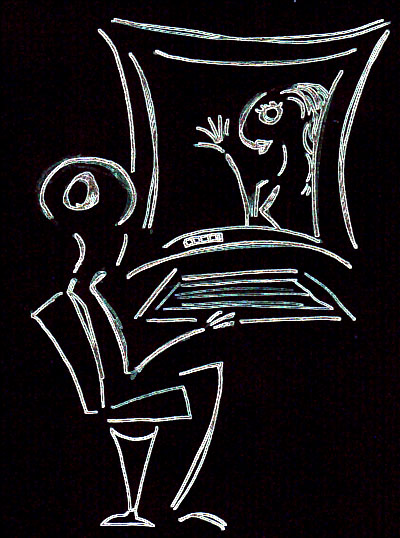
|
They say that what makes two hearts beat as one is changing. A shared moment on the dance floor swaying to a gentle waltz is now as likely to take place on two computer monitors as in one ballroom. In Second Life a couple might share a moment of two avatars moving in unison on a virtual disco floor with animated avatars often of unearthly and unreal beauty and perfection that reflect only the desires of the avatars controllers, however different in body they may be from their own digital projections. And these moments do not stop with dance: animations exist to cover a multitude of fantasies from the explicit to the innocent. The extremes are striking: a couple might take pleasure in a virtual picnic under a unicorn fountain in a perfect glade or stumble too close to another unicorn and experience fully animated and unconventional sex. Second Life is not even a world dedicated to the sexual enterprises. Other virtual worlds exist now that mimic everything from a Red Light district in Amsterdam to fantastically mystical fetish worlds. Players in these environments enjoy the opportunity to realize possibilities that in the “real” world might be marginalized, banned, rejected or even impossible. The acceptable kind of virtual romance leads to real connections: advertisements for the successful marriages arising from a meeting on Match.com tout how the Internet can be the ultimate solution to loneliness and provide an outlet for finding the one true love promised in fairy tales—a love that can be hard to find in the physical spaces where finding the perfect mate in a crowd of imperfect matches can become a frustrating lifelong endeavor. Success stories for these connections always emphasize the creation of new weddings and the dream of lifelong mates: darker stories speak of adultery, of predators, of people who are not what they seem. Virtual sex worlds have been around in one way or another since the Internet emerged. Erotica-esque writer Susie Bright wrote a book in 1993, Sexual Reality: A Virtual Sex World Reader, that began to chronicle the enticement of these realities as they became especially appealing as concerns about AIDS and other STDs mounted and virtual space became a world where the viruses were much less life-threatening: while continual pop-ups from adult web sites may be annoying, they have much easier to come by cures and offer far fewer disruptions and threats to life. These virtual worlds can be a sanctuary: a place where the real body, at least, seems to be safe and protected while only the heart and mind are placed on the line, out in a space where these are the currency for creating romance. Online attraction can never really be physical. An avatar is not a physical body, and is nothing in relation to the body of the mind inhabiting the animation. An image sent through space might be marked as displaying the physical body of a would-be virtual lover that image can never be trusted. Virtual space demands its own truths: the traditional means of judging a lie cannot be relied upon; there is no body language or look in an eye to offer insight. Yet love has abounded in virtual worlds as early as the Internet became a live space. Even when the network formed almost entirely on text alone the potential for emotional projection rose. Janet Murray writes in Hamlet on the Holodeck of the ability of people to become emotionally tied to the experience of connecting in virtual space: MUDders and newsgroup members find it easy to project their deepest desires and fears unto people they have encountered only as words on a screen. People can fall in love very quickly over the Internet, and they also express their anger very easily. Some people put things on their home page that they have not told their closest friends. The enchantment of the computer creates for us a public space that also feels very private and intimate. In psychological terms, computers are liminal objects, located on the threshold between external reality and our own minds (Murray 99). The players Janet Murray observes are not interacting in the extensive virtual worlds that are ubiquitous today. These are the predecessors, the text based environments where only words disconnected from body betray desire, love, anger, fear. Words remain at the root of the modern virtual worlds, with text exchanged from avatar to avatar, sitting at the heart of new connections.
|